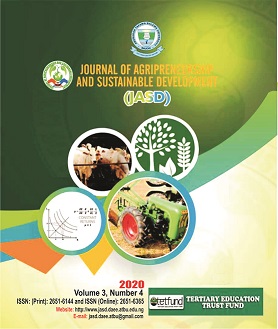ECONOMIC ANALYSIS OF CHILLI PEPPER PROCESSING IN KANO STATE, NIGERIA
DOI:
https://doi.org/10.59331/jasd.v3i4.170Keywords:
Chilli pepper, Gross margin, Livelihood, Processing, SpicesAbstract
The study was carried out in Kano State, Nigeria to determine the economic analysis of chilli pepper processing as a means of improving livelihoods in the study area. The researcher randomly selected 36 market processors and 33 home processors making a total of 69 sample size for the study. Descriptive statistics and gross margin model were used for the analysis. The result revealed that the age bracket of between 37-43 years (29%) dominated the chilli pepper processing enterprise and 34.8% had 6-10 years of experience. All the respondents were female and most (81.2%) had formal education. Gross margin analysis indicated that market processors along the value chain recorded a return of N180 per 0.4 kg of chilli pepper processed. The home chilli pepper processors added more value than their market counterparts with profits of N255 and N270 per 0.4 kg using modern and manual processing methods, respectively. Constraints encountered by chilli pepper processors in the study area include seasonality, high cost of other inputs used in processing, inadequate capital, health reasons and lack of patronage. The study concluded that chilli pepper processing was profitable. It was recommended that, in order to increase the revenue earnings of the processors which will thus improve their livelihoods, credit facilities should be made available to processors. Also, the chilli pepper processors’ cooperative groups should be formed to provide processing inputs at a subsidized rate to the processors.
Downloads

Downloads
Published
How to Cite
Issue
Section
License
Copyright (c) 2022 Journal of Agripreneurship and Sustainable Development

This work is licensed under a Creative Commons Attribution 4.0 International License.






